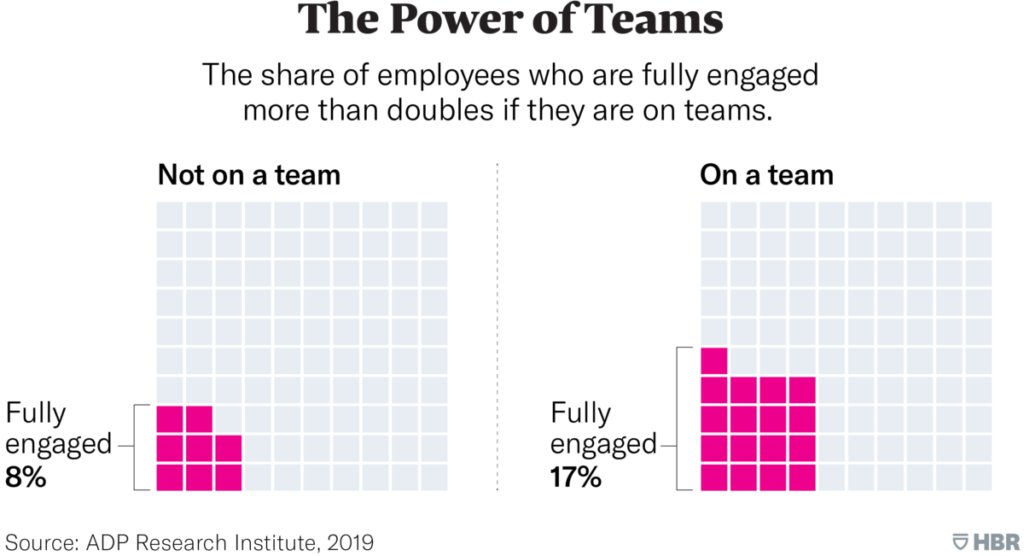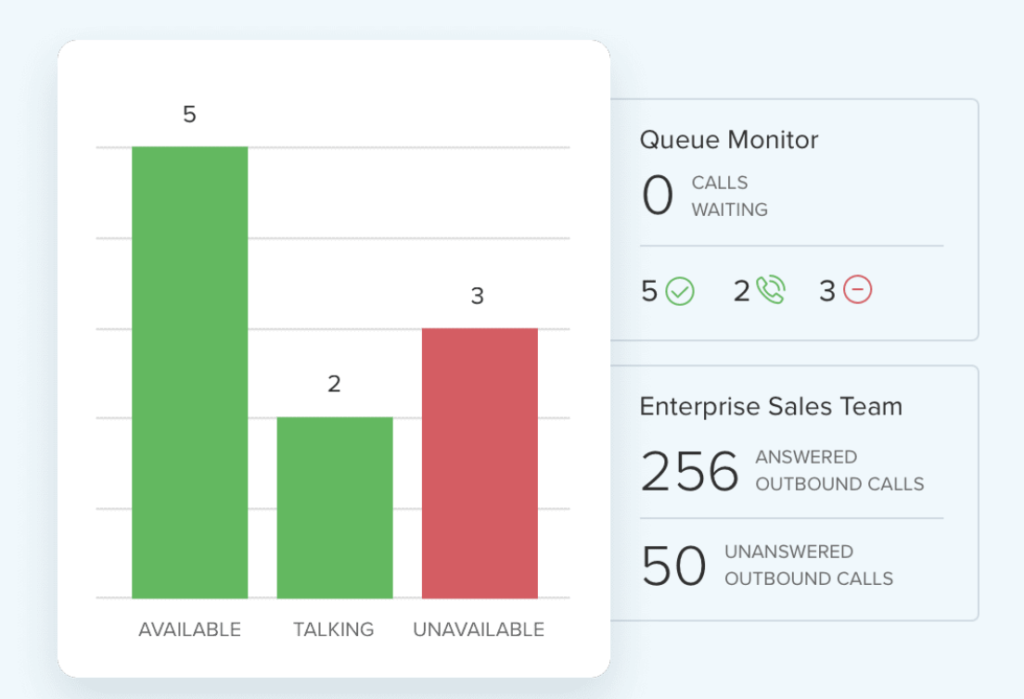A thousand-page strategy begins with a single goal.
The goal functions as the north star for the business, dictating how its resources will be marshaled over the course of a month, year, or years.
With sales, goals play a particularly critical role. While every other department in the company loads the gun, it’s the humble sales executive who pulls the trigger. All departments contribute to profits in some way, but the sales team faces tremendous pressure to perform. Aside from being part of one of the most challenging professions in business, sales departments are held heavily responsible for revenues, penalized for company failures, and rewarded for their successes.
RingCentral’s state-of-the-art communications technology has helped countless small businesses smash their sales targets. The common thread that runs through all these exciting case studies is that business goals focus as much on the process as they do on the outcome.
Yet, when small businesses underperform, goals are often the last place leaders think to look. Instead, (understandably) anxious leaders tend to obsess over things like incentive programs, sales pitching, etc. rather than examining where all these things flow from: goal-setting.
Let’s fix that.
In this article, we’ll cover:
- What a sales goal is
- 4 types of sales goals
- What constitutes SMART goals in sales
- How to set the right sales goals for your business
- How to measure sales goals in 3 steps
Up your team’s sales game and help them close more deals with these free cold outreach scripts. ☎️
What is a sales goal?
Sales goals are objectives a company sets that influence its profits and revenue. These objectives could be results focused, like sales targets and key performance indicators (KPIs), or they could be process focused, like customer retention, or sales team motivation.
Since many things that have nothing to do with sales technique or performance affect sales team success, sales goals needn’t focus just on sales. Sales goal setting could and should go beyond just numbers and targets.
4 types of sales goals (with examples)
There are as many types of sales goals as there are things that affect sales. Your goals could help motivate salespeople to improve upon their strengths, help them build upon a problem area, or help them take advantage of an opportunity in a new market.
Here are just a few examples:
1. Team goals
Sales has always been a bit like a team sport. Sales leaders are famous for being more like coaches rather than managers, and motivational sales meetings can sometimes look like pregame huddles when done right. And that’s probably for the best. Research shows that employee-engagement doubles among employees who are part of a team.1 Team goals are set to cultivate the team’s spirit and skills. They can also include team targets.

Examples of team sales goals
- “Improve employee engagement survey scores by 15% through more flexible WFH policies and team incentives by the end of the year.”
- “Provide 100 hours of advanced sales training to all 30 employees of department X in Q3.”
2. Metrics
Sales metrics are all the numbers that represent your individual employees’, teams’ and company’s performance. Data from sales metrics are crucial for informing your strategies for forecasts and sales incentive programs.
These could include (but not be limited to):
- Sales KPIs such as revenue by territory, market, or product; Net Promoter Score (NPS); etc.
- Activity sales metrics such as the number of calls made, meetings scheduled, referral requests, etc. Here are some of the activity goals you can pull from RingCentral’s platform, for instance:

- Pipeline sales metrics such as the average length of the sales cycle, and average conversion rate by sales funnel stage.
You can access tons of relevant call and video-meeting related metrics through RingCentral’s outbound contact center solution. Take a quick look in the video below.
Examples of metrics goals
- “Shorten the average sales cycle of product X to 6 weeks from 9 weeks in territory Y by the end of the year.”
- “Increase market penetration in territory X by 13 percentage points before November 2020.”
-
3. Strategic sales goals
Strategic goals have to do with hitting milestones on the roadmap laid out by your overall strategy. These goals have less to do with numbers and more to do with the bigger picture.
Is there a particular product you want to focus on? Maybe you’re seeing a lot of sales of Product X nationwide, but you would like to enter a new sales territory? Or, you’ve been getting information that some of your reps’ tactics are too aggressive and need to rethink your approach.
Examples of strategic sales goals
- “Implement a new sliding-scale incentive program for sales executives by March 2021.”
- “Improve communication and collaboration across sales, marketing, and customer success teams through a unified communications platform.” (See how Success Mortgage Partners accomplished this with RingCentral.)
-
4. Customer satisfaction goals
Customer satisfaction begins way before the product is even a thought in the prospect’s mind. And it goes hand-in-hand with sales.2 According to research from PwC, 73% of consumers say that customer experience is an important factor in their decision making.3
Customer experience analytics can even provide clues into what needs to be improved in the sales process, and vice versa.
Examples of customer satisfaction goals
- “Reduce customer onboarding time by 24% using Customer Relationship Management (CRM) tools.
- “Improve Customer Satisfaction score (CSAT) by 10 percentage points among surveyed customers.”
-
What are SMART goals in sales?
Sales goals shouldn’t be kept a secret from salespeople. And for that reason, the goal itself, the phrasing, and the way it is communicated are all crucial to get right. Goals should be phrased in such a way that they leave nothing to the imagination.
The worst way to phrase a goal is to make it vague. You might as well set a New Year’s resolution to go vegan without knowing what vegan even means.
But so many sales goals are just that: “Make more money” when they should be SMART: specific, measurable, achievable, relevant, and time-bound.
| Specific | Sales goals should be as detailed as possible and articulate specifics. Good goal statements answer the who, what, why, where, when, and how. |
| Measurable | What does success look like, but most importantly, how can you tell? What metrics, KPIs, and sales software will you use? |
| Achievable | This is probably the most crucial aspect of goal setting. Set the bar too high, and you risk demotivating your team. Set the bar too low, and you encourage complacency. |
| Relevant | This goes without saying, but the goal has to be relevant to the people it is being set for. It has to make sense within the job function and contribute in some way to the individuals who are helping to achieve the goal. |
| Time-bound | Oh, you want to make a million dollars in sales? Sure, you could do that in five years. But can you wait five years? Having a reasonable time frame for a goal can generate a sense of urgency and motivation to achieve it. |
“The California sales team should bring in a total of $500,000 (measurable, achievable) from sales of product A, product B, and product C in the San Francisco area (specific) in the next quarter (time-bound), without putting in overtime. The best performing salespeople will be given their incentives during the quarterly sales meeting in December (relevant).”A SMART version of “Make more money” could look like this:
How to set the right sales goals for your business
The right goals are SMART of course, but they also inspire and energize the people responsible for achieving them. The right sales goals reinforce and incentivize the right things—steering the business not just towards its revenue aspirations but also towards its long-term big-picture goals.
Most importantly, they do this without sacrificing the goose for the golden egg. They prioritize the company’s employees and encourage sustainable growth. Here’s a brief guide to setting them:
1. Select your KPIs and time period
To maximize success, keep things simple and select at most three to five KPIs to focus on for your chosen time period.
Make sure that the goals aren’t too high and avoid stretch goals if possible. Consultant Daniel Markowitz has suggested that unattainable stretch goals are demotivating and can foster unethical behavior and excessive risk-taking.4
If you’re new to this, or are unable to confidently set realistic, data-informed goals for any reason, set a short time frame for your goals. Short time periods limit the potential damage from unrealistic goals. However, if you frequently work with longer sales cycles, short time frames may not help much. In this case, err on the side of caution.
2. Look at the data from the past few years (and then throw it away)
There are excellent reasons why you would want to base your goals on forecasts based on performance over the past few years. It’s a method that’s been around a long time, and despite life’s unpredictability, it’s worked pretty well so far.
But it’s important not to blindly raise the bar year over year without considering the other factors that affect sales performance and allowing for unforeseen circumstances like pandemics, economic slumps, or abrupt changes in consumer behavior. Use past year data as a guide or as a diagnostic tool to identify problem areas, but forecast with care.
3. Study the market situation
Capture opportunities business growth while they’re blazing hot. For example, if you run a clothing business and the market is chasing athleisure, increase your targets for your athleisure offerings. Make sure that you pursue the most profitable goals, with the largest margins, and raise the bar for easy wins.
If you were initially gunning for market share in territory A, but later find out that territory B is more practical, be flexible enough to regroup even in the middle of the time period.
4. Reward a range of performance
To account for unforeseen circumstances, it might help to set goals in a sliding range especially while designing a performance rewards program. Rather than incentivizing just one figure, say of $200,000 for a salesperson, set a “success range” of $180,000 to $220,000 and reward your sales team on a sliding scale. This makes success more accessible for a range of performers and will motivate less than brilliant performers to keep up their efforts well into the next time period.
5. Set goals for activities, not just metrics
Sometimes, even with the best of efforts, good sales people, especially newer ones, might not be able to smash their targets and get discouraged. To avoid this, make sure that you set process goals that reward effort—not just achievement.
Activity goals might include new leads generated, meetings arranged, or upsells. According to the Harvard Business Review (HBR), “Setting goals for sales activities can sustain salespeople’s motivation throughout long sales cycles.”5
How to measure sales goals in 3 steps
What gets measured gets managed. But you’re a small business and chances are you’re strapped for time. So how can you go about measuring sales goals without spending too much time recording your progress?
Step 1: Hook up your tech and software stack
It’s really hard to make a habit of things you find tedious and annoying to do, and since your salespeople would rather spend more time selling things than creating weekly reports, make recording progress a breeze with a bit of help from tech.
You probably already use a CRM to manage your sales team. If not, you should look into whether it’s a good idea to invest in one. (It usually is.)
It’s easier to implement these tools while you’re still small so that you can establish practices that can help you even when your business (and your sales goals) expand.
Take a look at the software and hardware you need for your sales team to work. You’ll do well to invest in a communication and collaboration platform like RingCentral, where you can text, email, call, and video-conference from a single platform—and also access helpful real-time analytics and reports to track your sales team’s performance.
RingCentral also integrates with a number of great sales apps and CRMs like Salesforce, Zoho, and AgileCRM so that you can dial up prospects right from your computer screen and log conversations and notes:
Step 2: Take a look at your analytics
Think of data and what comes to mind is a big, unwieldy concept that should be of concern to giant corporations, not small businesses like yours, but overcome that. With the right tools, it’s not hard, and the effort will pay off in the long run. The more data you gather, the more accurate and refined your goal-setting process will be.
If you’re using RingCentral along with a CRM, this part will be easy. With a little bit of help from task automation and workflow management tools, you can easily share information between apps and make recording your team’s performance a breeze.
If you have set hard-to-quantify sales goals that have to do with team culture or collaboration efficiency, consider using surveys and qualitative interviews to gather data points to chart your progress.
Step 3: Synthesize the information
You won’t always get everything right. There will always be goals you hit and goals you miss. Success is a process of trial and error—and you may find along the way that you need to tweak your targets and compensation plans. That’s perfectly alright. Mistakes are information. What can you do with the information? How can you present it in a way where you can learn from it and re-strategize appropriately?
Consider hiring a business consultant to interpret the data and help you strategize. If you’re tech savvy, consider using artificial intelligence and machine learning to analyze the info for you.
XSELL AI and Realtime Call Tracking is a tool that continuously studies your customer interactions by phone, live chat, and SMS text; tracks the conversations in real time; and provides recommendations to improve conversion rates. And the best part? It integrates with communication tools (like RingCentral)!
Do your sales goals need reworking?
If you’ve read ‘til the end, you’re probably wondering if your own sales goals are lowering your revenues. Off the cuff, here’s a quick way to tell if that’s the case: take a look at your sales team’s performance over the past couple of incentive periods.
A good benchmark is that at least 60 to 70% of your team should be able to reach your goals. If not, they’re probably too high. According to HBR, “When 10%–20% of salespeople miss goals, the problem might be the salespeople. But when most salespeople miss, the problem is their goals.”6
So, how are your sales goals looking? Is the problem your team or your goals?
1hbr.org/cover-story/2019/05/the-power-of-hidden-teams
2researchgate.net/publication/235263181_The_Role_of_the_Sales_Employee_in_Securing_Customer_Satisfaction
3pwc.com/us/en/services/consulting/library/consumer-intelligence-series/future-of-customer-experience.html
4hbr.org/2012/04/the-folly-of-stretch-goals
5hbr.org/2019/06/7-ways-sales-teams-can-set-better-goals
6hbr.org/2016/07/can-your-sales-team-actually-achieve-their-stretch-goals
Originally published Aug 19, 2020, updated Dec 30, 2022





